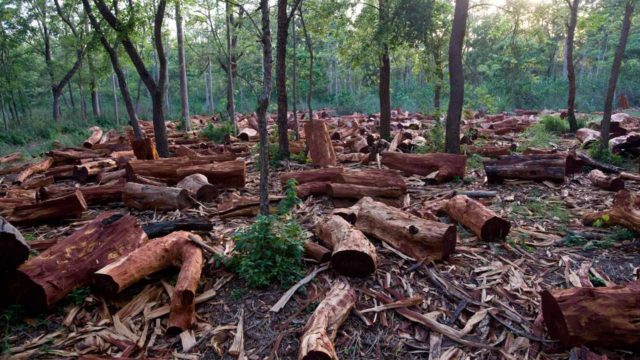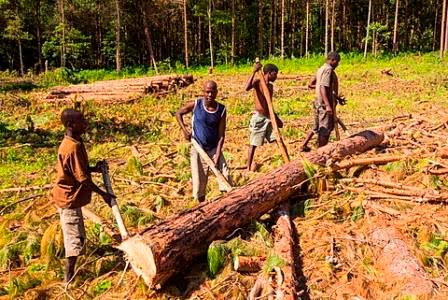Global Issues
Deforestation: does it causes more harm than good? -By Jaiyeola Roseline Oluwatosin
There should be robust enforcement of law by the government, which dissuades deforestation; culprit must be brought to book. These factors coupled with others, if checked will go a long way to curtail the spate of deforestation around the globe.

Human activities on the environment or anthropogenic impact on the environment has cause lot of damage to our environment in so many ways and these includes changes to biophysical environments, ecosystems, biodiversity, and natural resources caused directly or indirectly by humans, including global warming, environmental degradation such as ocean acidification mass extinction and biodiversity loss, ecological crisis, and ecological collapse. Modifying the environment to fit the needs of society is causing severe effects.
Deforestation involves the cutting down of trees from land without replacement and then converting it to non-forest use. For example, commercial purpose ( building of schools, construction of farm etc), production of chacoal, construction of furniture and building of houses etc. In many part of the world, anout 15 million to 18 million hectares of forest are destroyed every year, on average 2,400 trees are cut down each minute.

Deforestation causes extinction, changes to climatic conditions, desertification, and displacement of populations, as observed by current conditions and in the past through the fossil record.
Changes like these have triggered climate change, soil erosion, poor air quality, and undrinkable water. These negative impacts can affect human behavior and can prompt mass migrations or battles over clean water.
Trees cover large area of land and thus prevent the washing away of top soil mostly during raining season, but when they are been cut down, it expose the area to quicker transport of surface water and easily washing away of the most important nutrients leading the land to erosion and flood which then moves out to the nearby environment destroying farms,goods,houses and properties.
Deforestation disrupts weather pattern.Tress protect the soil from been directly overheated by the sun, but when it been cutdown the coverage is remove creating hotter and drier weather as a result changing the weather pattern of such environment thus increasing drought, desertification, crop failures, melting of the polar ice caps, and displacement of major vegetation regime.

When part of a forest is removed, the trees no longer transpire this water instead the water is being absorb by the soil resulting in a much drier climate. Deforestation reduces the content of water in the soil and groundwater as well as atmospheric moisture. The dry soil leads to lower water intake for the trees to extract.
Forests support biodiversity but deforestation is known to cause the extinction of many species resulting in a degraded environment with reduced biodiversity.This in turn provides habitat for wildlife, but as a result of logging most organism that find shelter in the soil and around the trees escape from the environment in search for another and conducive habitat where they are saved and can function.
Forests also foster medicinal conservation where by Herbal doctor make use of some of those tress mostly (leaves,stem,root and bark) to cure many sickness and illness, but when they out of place it becomes difficult for them to find and many Botanist and pharmacy make use of those plant for production of medicine in the medical line to cure disease.
Disease-carrying hosts which expands to new geographic areas/neighboring habitat (species are pathogen) have the ability to find new hosts in previously unexposed regions. As these pathogens and species come into closer contact with humans, they are infected both directly and indirectly and most of this disease are contagious which can further affect everyone in the geographic area ( transfer from one person to another).

Forest diseases include malaria, Chagas disease (African trypanosomiasis causing sleeping sickness), leishmaniasis, Lyme disease, HIV and Ebola etc.
Tropical forest trees like the green plants, take in carbondioxide and release oxygen during photosynthesis. Plants also carry out the opposite process known as respiration in which they emit carbondioxide, but generally in smaller amounts than they take in during photosynthesis. When trees are cut down and burned or allowed to rot, their stored carbon is released into the air as carbondioxide which then contribute to global warming.
However, in a bid to decipher the lingering problem of deforestation, the practice of replacing every cut down tree with new ones must come into play; thus, breeding new varieties of plant does not expose the soil to hottness from the sun.
While some rural dwellers who ventured into cutting down of trees to earn little cash and other momentary benefits wouldn’t know the harzardous nature of deforestation, there is need to hold seminars and workshops at intervals to widen their horizon on the dangers of deforestation and the need to abstain from the practice.
There should be robust enforcement of law by the government, which dissuades deforestation; culprit must be brought to book. These factors coupled with others, if checked will go a long way to curtail the spate of deforestation around the globe.
Jaiyeola Oluwatosin, a student of Animal Biology Federal University of Technology, Minna.

















